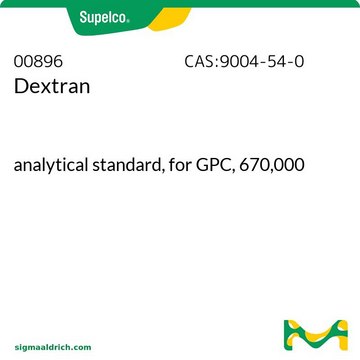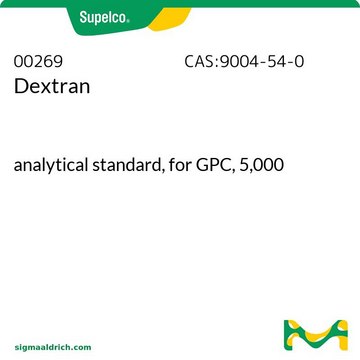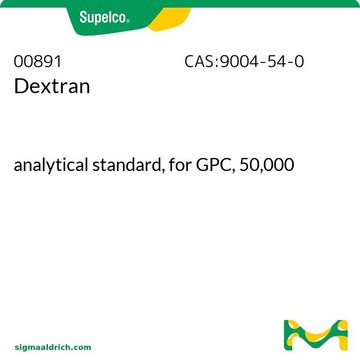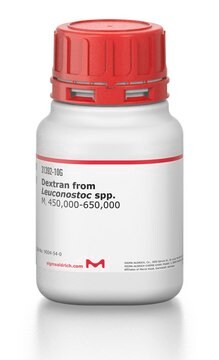All Photos(1)
About This Item
Linear Formula:
[C6H10O5]n
CAS Number:
EC Number:
MDL number:
UNSPSC Code:
12352201
NACRES:
NA.24
Recommended Products
grade
analytical standard
for GPC
Quality Level
form
powder or crystals
mol wt
Mn ~236,300
Mp ~276,500
Mw ~409,800
analyte chemical class(es)
oligosaccharides
technique(s)
gel permeation chromatography (GPC): suitable
Mw/Mn
~1.73
application(s)
food and beverages
InChI
1S/C18H32O16/c19-1-5(21)9(23)10(24)6(22)3-31-17-16(30)14(28)12(26)8(34-17)4-32-18-15(29)13(27)11(25)7(2-20)33-18/h1,5-18,20-30H,2-4H2
InChI key
FZWBNHMXJMCXLU-UHFFFAOYSA-N
Looking for similar products? Visit Product Comparison Guide
Related Categories
General description
Dextran (mol. wt. 410,000) belongs to the family of neutral polysaccharides, which are recognized as contaminants in sugar processing and other food production industries. These are composed of chains of D-glucose units connected by alpha-(1-6) linkages of varying lengths. They are found as bacterial extracellular polysaccharides and reportedly synthesized from sucrose by beneficial lactic acid bacteria, such as Leuconostoc mesenteroides and Lactobacillus brevis. They are incorporated in bakery products to improve the crumb texture, softness, and loaf volume, as stabilizers and additives in confectionery, flavor extract, icing compositions, beverages including soft drinks, milk, etc.
Application
- Dextran in Drug Delivery: A study in "Journal of Biomedical Materials Research Part A" demonstrated how dextran, a biopolymer, enhances wound healing. It focused on collagen-polyurethane-dextran hydrogels, which inhibit inflammation and promote collagen fibrillogenesis, making dextran crucial for tissue engineering and medical applications (Aguayo-Morales et al., 2024).
- Dextran as a Blood Plasma Expander: Research in "Redox Biology" highlighted the role of dextran in reducing systemic iron overload stress. This study provides insights into how dextran′s properties are beneficial for managing conditions like anemia and other blood volume deficiencies (Zhao et al., 2024).
- Dextran in Cell Culture: An article in ""International Journal of Biological Macromolecules"" explored the use of dextran-based antibacterial hydrogels. These gels are used for fluorescent sensors in bioanalytical applications, showing dextran′s utility in cell culture and microbial monitoring (Bai et al., 2024).
Packaging
Bottomless glass bottle. Contents are inside inserted fused cone.
Storage Class Code
11 - Combustible Solids
WGK
WGK 2
Flash Point(F)
Not applicable
Flash Point(C)
Not applicable
Personal Protective Equipment
dust mask type N95 (US), Eyeshields, Gloves
Choose from one of the most recent versions:
Already Own This Product?
Find documentation for the products that you have recently purchased in the Document Library.
Customers Also Viewed
Dmitri Simberg et al.
Biomaterials, 30(23-24), 3926-3933 (2009-04-28)
In order to understand the role of plasma proteins in the rapid liver clearance of dextran-coated superparamagnetic iron oxide (SPIO) in vivo, we analyzed the full repertoire of SPIO-binding blood proteins using novel two-dimensional differential mass spectrometry approach. The identified
Ana Luisa Miranda-Vilela et al.
Journal of biomedical nanotechnology, 9(7), 1261-1271 (2013-08-06)
This work aimed to test a dextran-functionalized magnetic fluid (DexMF) sample in mediating magnetohyperthermia to treat an advanced clinical Ehrlich-solid-tumor, to verify the effects of oral antioxidant administration of pequi-oil on this treatment and to investigate the potential of these
R D Zysler et al.
Journal of biomedical nanotechnology, 9(1), 142-145 (2013-05-01)
We propose a new method for determining the quantity of superparamagnetic iron oxide nanoparticles (Fe3O4, SPIONs) embedded in animal tissue using magnetization measurements. With this method, the smallest detectable quantity of magnetite nanoparticles in a tissue sample is -1 microg.
Farwa Sarwat et al.
Pakistan journal of pharmaceutical sciences, 26(4), 793-797 (2013-07-03)
Leuconostoc are known to produce dextran, which have great commercial importance in chemical, medical and food industry. The present study is an attempt to select the best medium for the isolation of indigenous dextran producing Leuconostoc, measuring their enzyme activities
Wai-Leung Langston Suen et al.
Investigative ophthalmology & visual science, 54(6), 4358-4365 (2013-06-01)
This study aims to determine the in vivo effectiveness of low-frequency ultrasound in mediating the transport of macromolecules to the posterior segment of the eye via transscleral route. It investigates if damage is caused by ultrasound at the tested operation
Our team of scientists has experience in all areas of research including Life Science, Material Science, Chemical Synthesis, Chromatography, Analytical and many others.
Contact Technical Service










